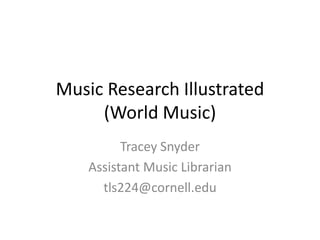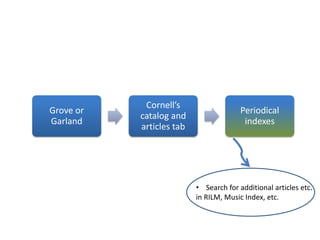Music Research Illustrated (World Music)
- 1. Music Research Illustrated (World Music) Tracey Snyder Assistant Music Librarian tls224@cornell.edu
- 2. Building a bibliography more books books other stuff Your bibliography
- 3. The formats youŌĆÖll find books book chapters journal articles dissertations conference papers
- 4. The content youŌĆÖll read elements of the music social context of the music historical perspectives on the music
- 5. The tools youŌĆÖll use CornellŌĆÖs Grove or Periodical catalog and Garland indexes articles tab Grove Music Online or Garland Encyclopedia of World Music
- 6. CornellŌĆÖs Grove or Periodical catalog and Garland indexes articles tab ŌĆó Select citations from the bibliography of the article about the genre, composer, etc.
- 7. CornellŌĆÖs Grove or Periodical catalog and Garland indexes articles tab ŌĆó Locate the selected items (catalog for books, articles tab for e-articles) ŌĆó Search for additional items (subject headings, etc.)
- 8. CornellŌĆÖs Grove or Periodical catalog and Garland indexes articles tab ŌĆó Search for additional articles etc. Search for additional in RILM, Music Index, etc. articles etc. in:
- 9. Summary: discovering writings Grove or CornellŌĆÖs catalog Periodical Garland and articles tab indexes ŌĆó Select ŌĆó Locate the ŌĆó Search for citations selected additional from the items articles etc. bibliography (catalog for in: of the article books, ŌĆó RILM about the articles tab ŌĆó Music genre, for e-articles) Index composer, ŌĆó Search for etc. additional items (subject headings, etc.)
- 10. Following the trail of citations Find Find it more like it Find out
- 11. Mastering the bibliographic universe
Editor's Notes
- #3: You wonŌĆÖt just be reading books. Your task is to digest several pieces of scholarly literature in various formats and demonstrate your command of the literature in your paper. It all begins with compiling a bibliography of writings, which is its own distinct process. You can learn a lot just from gathering sources to read.
- #4: YouŌĆÖll find writings in some of these formats. Journal articles are a hugely important component of the scholarly literature. Why you want articlesŌĆöexplore a narrow topic in good detail.
- #5: The writings will shed light on the music in different ways. They may discuss the music and text, provide social commentary relevant to the time and place, or summarize historical perspectives on the music.
- #6: But rather than search one format at a time or one content type at a time, you are going to search everything at once in a three-part journey, that begins with Grove Music Online (or some other reference source), proceeds to CornellŌĆÖs catalog, and then to periodical indexes. IŌĆÖll explain what all of these things are.
- #7: Phase one. Who has used Grove? ItŌĆÖs a good starting point for music research.
- #8: Now that we have a few citations and weŌĆÖve located some chosen items, weŌĆÖre ready for phase two, where we expand our search and look for additional items. WeŌĆÖll do that in the catalog.
- #9: And here we are at the last leg of this journey.
- #11: ItŌĆÖs an iterative process. You might think of it asŌĆ”And if you do that,ŌĆ”










